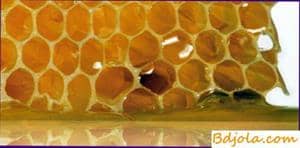
The composition of the wax includes about 50 chemical compounds, among which up to 75% of complex fats, 12-15% of limit carbohydrates and 13-15% of free fatty acids. Wax also contains trace elements, substances that give it a certain color (white, yellow, reddish) and odor.
Wax is dissolved only in fatty essential oils, gasoline, turpentine, almost insoluble in alcohol and completely insoluble in glycerin and water.
The peculiar smell of wax depends on the smell of nectarones. With a special processing of wax, you can get a very valuable fragrant substance, which by its qualities is not inferior to pink and jasmine oils and is successfully used in perfumery for making high-grade perfume.
Wax is easier for water, its melting point is 61-63 њ C. At higher temperatures it melts, turning into a so-called wax oil.
When processing wax, it must be re-heated in a container made of aluminum, stainless steel or enameled (without damage to the enamel) to prevent its reaction with the metal.
Жизнь пчелиной семьи. В старину пчеловоды умели.
Beeswax